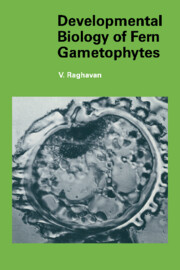Book contents
- Frontmatter
- Contents
- Preface
- Abbreviations
- 1 Introduction
- PART I THE BEGINNING
- PART II GROWTH AND MATURATION
- 6 Developmental physiology of gametophytes – the germ filament
- 7 Developmental physiology of gametophytes – induction of planar growth
- 8 Role of protein and nucleic acid synthesis in planar growth
- 9 Vegetative and reconstitutive growth of gametophytes
- PART III REPRODUCTIVE STRATEGIES
- PART IV DEVELOPMENTAL OPTIONS
- References
- Author index
- Subject index
8 - Role of protein and nucleic acid synthesis in planar growth
Published online by Cambridge University Press: 11 September 2009
- Frontmatter
- Contents
- Preface
- Abbreviations
- 1 Introduction
- PART I THE BEGINNING
- PART II GROWTH AND MATURATION
- 6 Developmental physiology of gametophytes – the germ filament
- 7 Developmental physiology of gametophytes – induction of planar growth
- 8 Role of protein and nucleic acid synthesis in planar growth
- 9 Vegetative and reconstitutive growth of gametophytes
- PART III REPRODUCTIVE STRATEGIES
- PART IV DEVELOPMENTAL OPTIONS
- References
- Author index
- Subject index
Summary
We have seen in the previous chapter that planar growth of the protonema in blue light is due to a change in the orientation of the plane of division of the terminal cell from transverse to oblique or longitudinal. This response to blue light may be the microscopically visible manifestation of a sequence of complex biochemical processes in the cell subsequent to the photochemical reaction. These processes are initiated by the transcription of a particular set of polysomal mRNA which moves into the cytoplasm to direct the synthesis of new proteins. The general view is that the pattern of nucleic acid and protein synthesis in the protonema might provide the operational criterion for gene transcription during planar growth. We will use this as a frame of reference for discussion in this chapter on the reprogramming of the cellular machinery of the gametophyte during photomorphogenesis. The approach chosen here is to introduce the various facets of earlier investigations and to focus on those concepts which have received renewed experimental attention in recent years. This subject is also considered in the reviews of Miller (1968a), DeMaggio and Raghavan (1973), and Raghavan (1974c).
Protein synthesis
A change in the rate synthesis of enzymatic, regulatory and structural proteins is the basic attribute of an organism embarking on a specific mode of growth.
- Type
- Chapter
- Information
- Developmental Biology of Fern Gametophytes , pp. 152 - 167Publisher: Cambridge University PressPrint publication year: 1989



